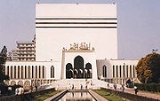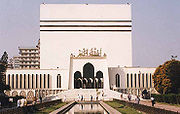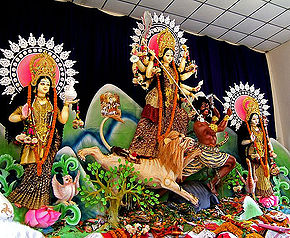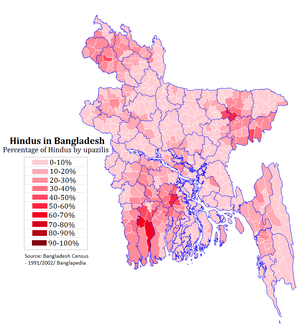
Religion in Bangladesh
Encyclopedia
Islam
is the largest religion of Bangladesh
; Muslim
s constitute 89.5 % of the population followed by Hindus who constitute 9.6 %. The remainder of Bangladeshis practice other religions such as Buddhism
and Christianity
. Religion has always been a strong part of identity, but this has varied at different times. A survey in late 2003 confirmed that religion is the first choice by a citizen for self-identification; atheism
is extremely rare.

Muslim
s constitute almost 90 percent of the population. Most Muslims in Bangladesh are Sunnis, but there is a small Shia community and even smaller the Ahmadiyya Muslim Community
. Most of those who are Shia reside in urban areas. Although these Shias are few in number, Shia observance commemorating the martyrdom of Ali's sons, Hasan and Husayn, is widely observed by the nation's Sunnis.
The Muslim community in the Bengal region developed independent of the dominant Islamic trends in India. The preservation of pre-Islamic cultural elements from Buddhist and Hindu periods made the commitment to Islam uniquely Bangladeshi. Features of Bangladeshi Hinduism, which differed in some respects from Hinduism in other parts of South Asia, influenced both the practices and the social structure of the Bangladeshi Muslim community. In spite of the general personal commitment to Islam by the Muslims of Bangladesh, observance of Islamic rituals and tenets varies according to social position, locale, and personal considerations. In rural regions, some beliefs and practices tend to incorporate elements that differ from and often conflict with orthodox Islam.


Hinduism
is the second largest religious affiliation in Bangladesh
, covering approximately 10 percent of the population as of 2001 census . In terms of population, Bangladesh is the third largest Hindu state of the world after India
, Nepal
.
In nature, Bangladeshi Hinduism closely resembles the forms and customs of Hinduism practised in the neighbouring Indian state of West Bengal
, with which Bangladesh (at one time known as East Bengal
) was united until the partition of India in 1947.
population adheres to the Theravada
school of Buddhism
.
Most of the followers of Buddhism in Bangladesh live in the South-Eastern region, especially in the Chittagong Hill Tracts
, Chittagong
and Comilla
district. Most of the Buddhists of Chittagong Hill Tracts belong to the Chakma
, Chak, Marma
, Tanchungya and the Khyang, who since time immemorial have practiced Buddhism. Other tribals, notably those who practice Animism, have come under some Buddhist influence, and this is true in the case of the Khumi and the Mru
, and to a lesser extent on the other tribes. Buddhism is also practiced by the Bengali speaking Baruas; who are almost exclusively Buddhist and are concentrated heavily in the Chittagong area.
 Christianity
Christianity
arrived in what is now Bangladesh
during the late sixteenth to early seventeenth century AD, through the Portuguese traders and missionaries.
Christians account for approximately 0.3% of the total population. Roman Catholicism is dominant; the remaining Christians are predominantly Protestant.
in Bangladesh begins previous to its independence when it was part of India. The roots of the Bahá'í Faith in the region go back to the first days of the Bábí
religion in 1844. During Bahá'u'lláh
's lifetime, as founder of the religion, he encouraged some of his followers to move to India. And it may have been Jamál Effendi who was first sent and stopped in Dhaka
more than once. The first Bahá'ís in the area that would later become Bangladesh was when a Bengali group from Chittagong accepted the religion while in Burma. By 1950 there were enough members of the religion to elect Bahá'í Local Spiritual Assemblies in Chittagong
and Dhaka
. The community has contributed to the progress of the nation of Bangladesh individually and collectively and in 2005 the World Christian Encyclopedia
estimated the Bahá'í population of Bangladesh at almost 10,000.
establishes Islam as the state religion but provides for the right to practice—subject to law, public order, and morality—the religion of one's choice. The Government generally respects this provision in practice; however, some members of the Hindu, Christian, Buddhist, and Ahmadiyya
communities experience discrimination. The Government (2001-2006) led by an alliance of four parties Bangladesh Nationalist Party
, Jamat-e-Islami Bangladesh, Islami Oikya Jote and Bangladesh Jatiyo Party banned the Ahmadiya literatures by an executive order.
Family laws concerning marriage, divorce, and adoption differ depending on the religion of the person involved. There are no legal restrictions on marriage between members of different faiths.
Islam
Islam . The most common are and . : Arabic pronunciation varies regionally. The first vowel ranges from ~~. The second vowel ranges from ~~~...
is the largest religion of Bangladesh
Bangladesh
Bangladesh , officially the People's Republic of Bangladesh is a sovereign state located in South Asia. It is bordered by India on all sides except for a small border with Burma to the far southeast and by the Bay of Bengal to the south...
; Muslim
Muslim
A Muslim, also spelled Moslem, is an adherent of Islam, a monotheistic, Abrahamic religion based on the Quran, which Muslims consider the verbatim word of God as revealed to prophet Muhammad. "Muslim" is the Arabic term for "submitter" .Muslims believe that God is one and incomparable...
s constitute 89.5 % of the population followed by Hindus who constitute 9.6 %. The remainder of Bangladeshis practice other religions such as Buddhism
Buddhism
Buddhism is a religion and philosophy encompassing a variety of traditions, beliefs and practices, largely based on teachings attributed to Siddhartha Gautama, commonly known as the Buddha . The Buddha lived and taught in the northeastern Indian subcontinent some time between the 6th and 4th...
and Christianity
Christianity
Christianity is a monotheistic religion based on the life and teachings of Jesus as presented in canonical gospels and other New Testament writings...
. Religion has always been a strong part of identity, but this has varied at different times. A survey in late 2003 confirmed that religion is the first choice by a citizen for self-identification; atheism
Atheism
Atheism is, in a broad sense, the rejection of belief in the existence of deities. In a narrower sense, atheism is specifically the position that there are no deities...
is extremely rare.
Islam

Muslim
Muslim
A Muslim, also spelled Moslem, is an adherent of Islam, a monotheistic, Abrahamic religion based on the Quran, which Muslims consider the verbatim word of God as revealed to prophet Muhammad. "Muslim" is the Arabic term for "submitter" .Muslims believe that God is one and incomparable...
s constitute almost 90 percent of the population. Most Muslims in Bangladesh are Sunnis, but there is a small Shia community and even smaller the Ahmadiyya Muslim Community
Ahmadiyya Muslim Community
The Ahmadiyya Muslim Community is the larger of two communities that arose from the Ahmadiyya movement founded in 1889 in India by Mirza Ghulam Ahmad of Qadian . The original movement split into two factions soon after the death of the founder...
. Most of those who are Shia reside in urban areas. Although these Shias are few in number, Shia observance commemorating the martyrdom of Ali's sons, Hasan and Husayn, is widely observed by the nation's Sunnis.
The Muslim community in the Bengal region developed independent of the dominant Islamic trends in India. The preservation of pre-Islamic cultural elements from Buddhist and Hindu periods made the commitment to Islam uniquely Bangladeshi. Features of Bangladeshi Hinduism, which differed in some respects from Hinduism in other parts of South Asia, influenced both the practices and the social structure of the Bangladeshi Muslim community. In spite of the general personal commitment to Islam by the Muslims of Bangladesh, observance of Islamic rituals and tenets varies according to social position, locale, and personal considerations. In rural regions, some beliefs and practices tend to incorporate elements that differ from and often conflict with orthodox Islam.
Hinduism


Hinduism
Hinduism
Hinduism is the predominant and indigenous religious tradition of the Indian Subcontinent. Hinduism is known to its followers as , amongst many other expressions...
is the second largest religious affiliation in Bangladesh
Bangladesh
Bangladesh , officially the People's Republic of Bangladesh is a sovereign state located in South Asia. It is bordered by India on all sides except for a small border with Burma to the far southeast and by the Bay of Bengal to the south...
, covering approximately 10 percent of the population as of 2001 census . In terms of population, Bangladesh is the third largest Hindu state of the world after India
India
India , officially the Republic of India , is a country in South Asia. It is the seventh-largest country by geographical area, the second-most populous country with over 1.2 billion people, and the most populous democracy in the world...
, Nepal
Nepal
Nepal , officially the Federal Democratic Republic of Nepal, is a landlocked sovereign state located in South Asia. It is located in the Himalayas and bordered to the north by the People's Republic of China, and to the south, east, and west by the Republic of India...
.
In nature, Bangladeshi Hinduism closely resembles the forms and customs of Hinduism practised in the neighbouring Indian state of West Bengal
West Bengal
West Bengal is a state in the eastern region of India and is the nation's fourth-most populous. It is also the seventh-most populous sub-national entity in the world, with over 91 million inhabitants. A major agricultural producer, West Bengal is the sixth-largest contributor to India's GDP...
, with which Bangladesh (at one time known as East Bengal
East Bengal
East Bengal was the name used during two periods in the 20th century for a territory that roughly corresponded to the modern state of Bangladesh. Both instances involved a violent partition of Bengal....
) was united until the partition of India in 1947.
Buddhism
About 0.7% (or just over 1,000,000 people) of BangladeshBangladesh
Bangladesh , officially the People's Republic of Bangladesh is a sovereign state located in South Asia. It is bordered by India on all sides except for a small border with Burma to the far southeast and by the Bay of Bengal to the south...
population adheres to the Theravada
Theravada
Theravada ; literally, "the Teaching of the Elders" or "the Ancient Teaching", is the oldest surviving Buddhist school. It was founded in India...
school of Buddhism
Buddhism
Buddhism is a religion and philosophy encompassing a variety of traditions, beliefs and practices, largely based on teachings attributed to Siddhartha Gautama, commonly known as the Buddha . The Buddha lived and taught in the northeastern Indian subcontinent some time between the 6th and 4th...
.
Most of the followers of Buddhism in Bangladesh live in the South-Eastern region, especially in the Chittagong Hill Tracts
Chittagong Hill Tracts
The Chittagong Hill Tracts comprise an area of 13,295 km2 in south-eastern Bangladesh, and borders India and Myanmar . It was a single district of Bangladesh until 1984. In that year it was divided into three separate districts: Khagrachari, Rangamati and Bandarban. Topographically, this is the...
, Chittagong
Chittagong
Chittagong ) is a city in southeastern Bangladesh and the capital of an eponymous district and division. Built on the banks of the Karnaphuli River, the city is home to Bangladesh's busiest seaport and has a population of over 4.5 million, making it the second largest city in the country.A trading...
and Comilla
Comilla
Comilla is a city in south-eastern Bangladesh, located along the Dhaka-Chittagong Highway. It is the administrative center of the Comilla District, part of the Chittagong Division. The Eastern Wing of Bangladesh Highway Police is located in Comilla....
district. Most of the Buddhists of Chittagong Hill Tracts belong to the Chakma
Chakma people
The Chakmas , also known as the Changhma , are a community that inhabits the Chittagong Hill Tracts of Bangladesh and the North-East India. The Chakmas are the largest ethnic group in the Chittagong Hill Tracts, making up more than half the tribal population. Chakmas are divided into 46 clans or...
, Chak, Marma
Marma
The Marma also known as Magh or Mog are Arakanese descendants inhabiting the Chittagong Hill Tracts of Bangladesh since the Arakan kingdom period in the 16th century AD. In the late 20th century, their population stood at over 210,000. Ethnically related to the Myanmar, they are largely followers...
, Tanchungya and the Khyang, who since time immemorial have practiced Buddhism. Other tribals, notably those who practice Animism, have come under some Buddhist influence, and this is true in the case of the Khumi and the Mru
MRU
MRU may refer to :* "Many Regrets Unable", a short reply to a social event invitation, normally followed by a reason for not attending. Used in various navies.* Mano River Union, a political union in Africa...
, and to a lesser extent on the other tribes. Buddhism is also practiced by the Bengali speaking Baruas; who are almost exclusively Buddhist and are concentrated heavily in the Chittagong area.
Christianity

Christianity
Christianity is a monotheistic religion based on the life and teachings of Jesus as presented in canonical gospels and other New Testament writings...
arrived in what is now Bangladesh
Bangladesh
Bangladesh , officially the People's Republic of Bangladesh is a sovereign state located in South Asia. It is bordered by India on all sides except for a small border with Burma to the far southeast and by the Bay of Bengal to the south...
during the late sixteenth to early seventeenth century AD, through the Portuguese traders and missionaries.
Christians account for approximately 0.3% of the total population. Roman Catholicism is dominant; the remaining Christians are predominantly Protestant.
Bahá'í Faith
The Bahá'í FaithBahá'í Faith
The Bahá'í Faith is a monotheistic religion founded by Bahá'u'lláh in 19th-century Persia, emphasizing the spiritual unity of all humankind. There are an estimated five to six million Bahá'ís around the world in more than 200 countries and territories....
in Bangladesh begins previous to its independence when it was part of India. The roots of the Bahá'í Faith in the region go back to the first days of the Bábí
Babi
Babi may refer to:* Babı, a municipality in Azerbaijan* Babi Dynasty, founded in 1735 by Muhammed Sher Khan Babi , Nawabs of this dynasty went on to rule over Junagadh in Gujarat, from the 18th to the 20th century....
religion in 1844. During Bahá'u'lláh
Bahá'u'lláh
Bahá'u'lláh , born ' , was the founder of the Bahá'í Faith. He claimed to be the prophetic fulfilment of Bábism, a 19th-century outgrowth of Shí‘ism, but in a broader sense claimed to be a messenger from God referring to the fulfilment of the eschatological expectations of Islam, Christianity, and...
's lifetime, as founder of the religion, he encouraged some of his followers to move to India. And it may have been Jamál Effendi who was first sent and stopped in Dhaka
Dhaka
Dhaka is the capital of Bangladesh and the principal city of Dhaka Division. Dhaka is a megacity and one of the major cities of South Asia. Located on the banks of the Buriganga River, Dhaka, along with its metropolitan area, had a population of over 15 million in 2010, making it the largest city...
more than once. The first Bahá'ís in the area that would later become Bangladesh was when a Bengali group from Chittagong accepted the religion while in Burma. By 1950 there were enough members of the religion to elect Bahá'í Local Spiritual Assemblies in Chittagong
Chittagong
Chittagong ) is a city in southeastern Bangladesh and the capital of an eponymous district and division. Built on the banks of the Karnaphuli River, the city is home to Bangladesh's busiest seaport and has a population of over 4.5 million, making it the second largest city in the country.A trading...
and Dhaka
Dhaka
Dhaka is the capital of Bangladesh and the principal city of Dhaka Division. Dhaka is a megacity and one of the major cities of South Asia. Located on the banks of the Buriganga River, Dhaka, along with its metropolitan area, had a population of over 15 million in 2010, making it the largest city...
. The community has contributed to the progress of the nation of Bangladesh individually and collectively and in 2005 the World Christian Encyclopedia
World Christian Encyclopedia
World Christian Encyclopedia is a reference work published by Oxford University Press, known for providing membership statistics for major and minor world religions in every country of the world, including historical data and projections of future populations.The first edition, by David B. Barrett,...
estimated the Bahá'í population of Bangladesh at almost 10,000.
Law, religion, and religious freedom
Although initially Bangladesh opted for a secular nationalist ideology as embodied in its Constitution, the principle of secularism was subsequently replaced by a commitment to the Islamic way of life through a series of constitutional amendments and government proclamations between 1977 and 1988. The ConstitutionConstitution
A constitution is a set of fundamental principles or established precedents according to which a state or other organization is governed. These rules together make up, i.e. constitute, what the entity is...
establishes Islam as the state religion but provides for the right to practice—subject to law, public order, and morality—the religion of one's choice. The Government generally respects this provision in practice; however, some members of the Hindu, Christian, Buddhist, and Ahmadiyya
Ahmadiyya
Ahmadiyya is an Islamic religious revivalist movement founded in India near the end of the 19th century, originating with the life and teachings of Mirza Ghulam Ahmad , who claimed to have fulfilled the prophecies about the world reformer of the end times, who was to herald the Eschaton as...
communities experience discrimination. The Government (2001-2006) led by an alliance of four parties Bangladesh Nationalist Party
Bangladesh Nationalist Party
The Bangladesh Nationalist Party , commonly referred to as the BNP, is the mainstream center-right political party in Bangladesh. BNP ruled Bangladesh total 18 years since her independence, the longest than any other party in Bangladesh...
, Jamat-e-Islami Bangladesh, Islami Oikya Jote and Bangladesh Jatiyo Party banned the Ahmadiya literatures by an executive order.
Family laws concerning marriage, divorce, and adoption differ depending on the religion of the person involved. There are no legal restrictions on marriage between members of different faiths.

